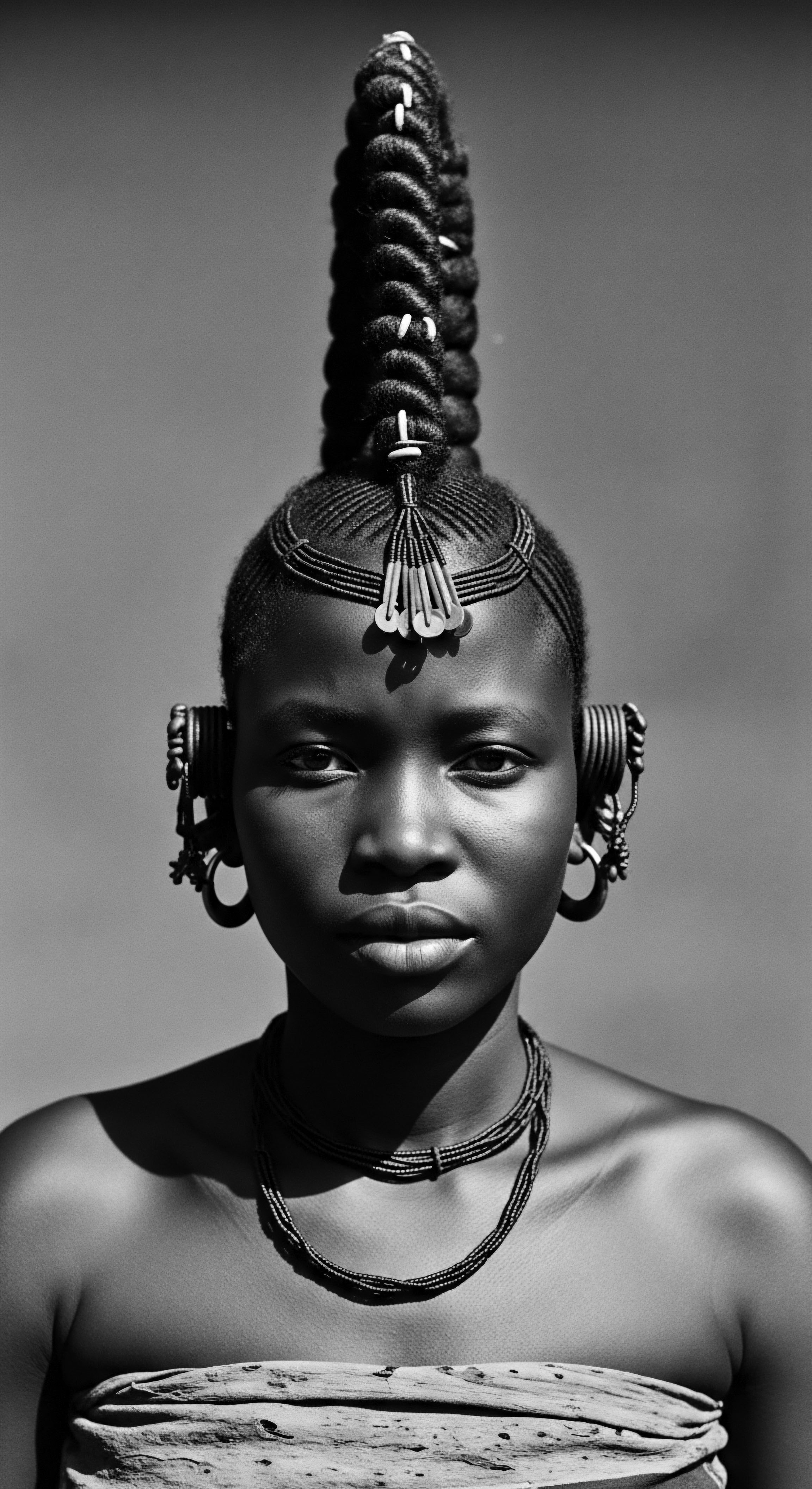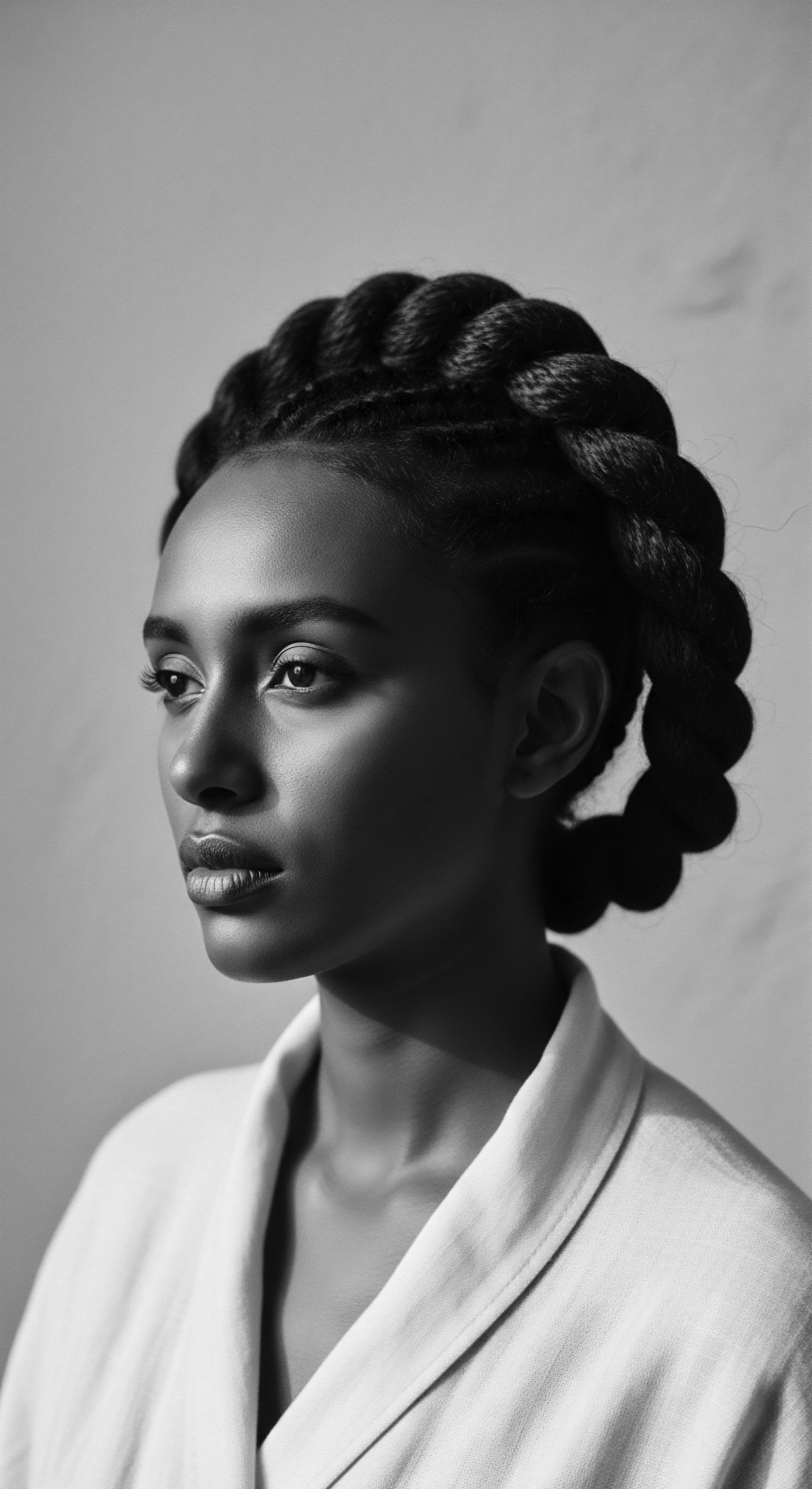
Fundamentals
The concept of Enslaved Communication, particularly when understood through the lens of textured hair heritage, delineates the profound and often clandestine ways in which enslaved African people, and their descendants, created and conveyed messages. These systems of shared understanding existed within brutal environments where overt forms of expression were ruthlessly suppressed. It speaks to a deep, inherent human desire for connection and self-preservation. This communication was not merely about transmitting information; it encompassed the very spirit of cultural survival, a testament to the resilience of the human soul.
Before the harrowing passage of the transatlantic slave trade, hair in various African societies held immense significance, serving as a complex visual language. Ancestral communities adorned and styled hair to signal a person’s lineage, social standing, marital status, or spiritual alignment. A hairstyle might tell tales of a woman’s wealth, her age, or even the particular tribe from which she hailed.
It was a living, breathing archive of identity, carefully tended and understood within communal bonds. The very act of hair care, often a shared ritual, fostered connections and allowed for the transmission of stories and wisdom across generations.
The arrival of enslaved Africans in the Americas brought with it an immediate and brutal assault on these deeply rooted cultural practices. Slave traders frequently shaved the heads of captured individuals, a dehumanizing act designed to strip them of their former identities and sever ties to their ancestral lands. This violent erasure of visible markers of heritage was a deliberate step in controlling and subjugating the enslaved population. Despite this systematic attempt to dismantle their sense of self, the inherent meaning of hair persisted, adapting to the harsh realities of their new existence.
Enslaved Communication through hair represents a profound, silent dialogue of cultural resilience, born from the urgent need to preserve identity and connection amidst dehumanization.
In this oppressive new world, the manipulation of textured hair took on renewed purpose, evolving into a subtle yet potent medium for silent dialogue. The tightly coiled strands of Black and mixed-race hair, with their unique structure, lent themselves to intricate designs that could hold more than just style. They became vessels for information, expressions of defiance, and conduits of ancestral memory.
Simple braided patterns, for instance, could transform into sophisticated diagrams. This basic explanation provides a foundational understanding ❉ Enslaved Communication was a system of covert signification, embedded within the everyday rituals and aesthetic choices surrounding hair, enabling survival, resistance, and the enduring continuity of cultural heritage.

Intermediate
Moving beyond a rudimentary understanding, the intermediate interpretation of Enslaved Communication delves into the adaptive ingenuity of enslaved individuals. When verbal communication was monitored, and written forms forbidden, hair became a canvas for shared intelligence and emotional solidarity. This was not a universal, codified language with a dictionary of meanings, but a dynamic, context-dependent system, often localized to specific plantations or communities, understood by those within the circle of trust. It was a dialogue conducted in plain sight, yet concealed from the oppressors.

The Language of Braids and Hidden Meanings
One of the most widely documented manifestations of this communication lies in the art of braiding. Pre-colonial African braiding techniques, which varied greatly across ethnic groups, were skillfully adapted to serve new, subversive purposes. The very act of braiding, often performed communally in fleeting moments of respite, became a ritual of shared existence. These sessions, usually taking place on Sundays, offered a rare opportunity for communal gathering, where whispered words intertwined with the rhythmic pull of strands, reinforcing bonds and circulating vital information.
For instance, the tightness, direction, or complexity of a cornrow pattern could carry specific meanings, signifying anything from the direction of an escape route to the presence of dangers or safe havens. It is understood that certain patterns became directional guides, their curves indicating paths through fields or forests, their intersections marking crossroads or river crossings. This subtle form of cartography, etched onto the scalp, was a profound act of resistance, a quiet assertion of agency when other avenues were blocked.
Hair, in its textured resilience, became a living parchment, bearing the unsung narratives of survival and the blueprints of whispered rebellion.
Beyond abstract patterns, hair also served a practical purpose in facilitating survival. Enslaved women, with remarkable foresight and resourcefulness, would sometimes braid rice seeds, grains, or even small gold nuggets into their hair. This practice was a silent act of provisioning for arduous journeys towards freedom, a testament to their deep connection to the earth and their ancestral knowledge of sustenance. The hair, therefore, became a discreet repository, holding not only symbols of liberation but also the very means of continued existence.
The significance of Enslaved Communication extends beyond mere practicalities; it speaks to the emotional and psychological fortitude of a people striving to maintain their humanity. Hair became a conduit for spiritual connection, a tangible link to the homeland and the ancestors whose traditions were under attack. Maintaining ancestral styles, even in modified forms, became a private act of cultural affirmation, a quiet refusal to let their heritage be completely erased. The very texture of their hair, once denigrated, became a source of pride and a unifying emblem.
| Pre-Colonial Function (Ancestral Africa) Marked tribal affiliation and social status. |
| Enslaved Communication Adaptation (Diaspora) Encoded escape routes and pathways to freedom. |
| Pre-Colonial Function (Ancestral Africa) Conveyed marital status and age. |
| Enslaved Communication Adaptation (Diaspora) Carried messages about danger or gathering points. |
| Pre-Colonial Function (Ancestral Africa) Expressed spiritual connection to deities. |
| Enslaved Communication Adaptation (Diaspora) Concealed sustenance like rice seeds or valuables. |
| Pre-Colonial Function (Ancestral Africa) Fostered communal bonding during styling. |
| Enslaved Communication Adaptation (Diaspora) Provided discreet spaces for sharing vital information. |
| Pre-Colonial Function (Ancestral Africa) The inherent adaptability of hair allowed it to transform from a social marker into a vital tool for survival and resistance. |

The Persistence of Hair Care Rituals
Despite the severe limitations and harsh conditions, hair care rituals persisted, evolving into acts of quiet rebellion. The tools were scarce – combs fashioned from salvaged wood or bone, oils rendered from animal fats, or found plant-based elements like shea butter or coconut oil, if available. These moments of tending to hair, though often brief and fraught with danger, sustained a communal spirit.
They provided spaces for storytelling, for sharing ancestral wisdom, and for reinforcing familial and communal bonds. This shared experience solidified identity and provided psychological solace, a brief reprieve from the dehumanizing daily existence.
Such practices underscore the deep heritage of hair care not merely as aesthetics, but as a holistic endeavor tied to physical wellbeing, mental fortitude, and spiritual preservation. The resilience demonstrated in maintaining these practices speaks volumes about the value attributed to hair as a living extension of self and heritage, a quiet assertion of human dignity that even the most brutal systems could not fully extinguish.

Academic
The academic definition of Enslaved Communication posits it as a complex system of semiotics and embodied knowledge, predominantly manifested through the manipulation and cultural coding of textured hair, which served as a critical survival mechanism and a repository of cultural heritage for enslaved African populations and their descendants. This construct extends beyond simple coded messages; it encompasses the systemic preservation of identity, the articulation of resistance, and the continuity of ancestral practices in a context of profound subjugation and cultural assault. Its inherent genius lay in its capacity for clandestine operation, transforming a fundamental biological attribute into a dynamic, multi-layered medium for communication and social cohesion.

Biological and Cultural Intersections ❉ The Hair as a Medium
The unique structural properties of afro-textured hair, characterized by its tightly coiled strands, elliptical cross-section, and dense packing, allowed for an exceptional capacity for manipulation and retention of form. This biological predisposition, when coupled with centuries of sophisticated African hair styling traditions, provided a fertile ground for the development of complex communication systems. The hair’s ability to hold intricate braided patterns, to be sectioned, and to be adorned with various elements, was not merely a cosmetic feature. It became an intrinsic component of a highly effective communication network, allowing for the discreet transmission of information that would be indecipherable to the uninitiated overseer.
The physiological aspect of hair, in its constant growth and regeneration, mirrored the persistent spirit of the enslaved. Each new strand, each new style, represented a continuation, a refusal to cease existing or expressing. This cyclical renewal provided a dynamic canvas upon which messages could be continuously refreshed, modified, or reinforced, making it a sustainable mode of covert exchange over time. It was a form of communication that was always present, always developing, and intrinsically tied to the body itself.

Case Study ❉ Cornrows as Cartographic Narratives in Colombia
A compelling historical example of Enslaved Communication, often relayed through rich oral traditions, is the documented use of cornrows as cartographic guides for escape in regions like colonial Colombia. This particular instance offers an invaluable lens through which to comprehend the ingenious adaptation of cultural practices under extreme duress. Accounts, particularly those tied to the maroon communities, such as Palenque de San Basilio, reveal the profound practical application of hair styling as a tool for liberation.
In Colombia, African women, many of whom were originally from West Africa where hair held deep symbolic weight, are said to have braided complex patterns into their hair to delineate escape routes through the dense terrain. One style, known as Departes, involved thick, tightly braided rows pulled into buns at the crown of the head, which purportedly signaled intentions to escape. Another configuration featured curved braids laid flat against the scalp, which were understood to represent the winding roads or waterways leading to safe havens. These intricate designs were not random; they were precise, visual maps, encoded in plain view, yet hidden from those who lacked the cultural context to decipher them.
The cartography of cornrows, often dismissed as folklore, represents an extraordinary testament to human intellect and survival, transforming beauty into a language of freedom.
Furthermore, these braids sometimes served as literal conduits for survival supplies. Historical narratives recount instances where enslaved individuals would secure small quantities of rice seeds, grains, or even gold nuggets within their braided styles. These provisions were crucial for sustaining escapees during their perilous journeys, highlighting a multi-layered functionality that bridged symbolic communication with tangible aid. This practice underscores the profound resourcefulness and deep-seated ancestral knowledge of agriculture and self-sustenance that was carefully preserved and transmitted through generations.
While some scholarly discussions question the complete extent of such practices due to the inherent lack of widespread written documentation from the enslaved perspective, the persistence of these oral histories within Afro-descendant communities offers compelling evidence of their cultural reality and impact. The very nature of covert communication under slavery necessitated its non-written, transient forms, making oral tradition the primary vessel for its transmission and preservation. This historical narrative is not diminished by the absence of European-documented proof; rather, it amplifies the significance of indigenous knowledge systems and cultural memory.

Oral Traditions and the Enduring Legacy
The transmission of Enslaved Communication strategies relied heavily on oral traditions, a cornerstone of African cultural heritage. Storytelling, communal gatherings, and the very act of shared hair grooming provided intimate spaces for the quiet exchange of vital information and cultural knowledge. This continuity of oral tradition ensured that the wisdom of resistance, survival, and identity was passed from one generation to the next, even when formal education was denied. These narratives, though not always codified in written form, served as enduring pedagogical tools, instructing and inspiring future acts of defiance and cultural retention.
- Shared Rituals ❉ Hair braiding sessions were often communal activities, fostering solidarity and providing a discreet environment for the exchange of news, plans, and emotional support among enslaved individuals.
- Symbolic Meanings ❉ Hairstyles conveyed deep cultural and spiritual significance, functioning as a silent affirmation of identity and connection to African roots, even in the absence of explicit verbal acknowledgment.
- Adaptability and Resilience ❉ The ability to adapt pre-existing African hair traditions to new, oppressive contexts demonstrates remarkable human ingenuity in the face of relentless attempts at cultural erasure.

The Socio-Political Dimensions of Hair and Identity
The enforcement of Eurocentric beauty standards during and after slavery profoundly impacted the perception of textured hair, deeming it unruly or unprofessional. The forced shaving of heads upon arrival in the Americas was a deliberate attempt to strip individuals of their cultural identity and pride. Despite this, the resilience of enslaved people found ways to subvert these oppressive norms.
The very act of maintaining one’s natural hair, or employing traditional styling techniques, became a quiet yet potent act of socio-political resistance. This defiance continued into post-emancipation eras, with the natural hair movement in the 1960s and 1970s directly challenging these ingrained biases, celebrating Afro hairstyles as symbols of pride and liberation.
The meaning of hair for Black and mixed-race communities transcends mere aesthetics; it embodies a deeply personal and collective historical narrative. The choices individuals make regarding their hair today are often informed by centuries of struggle and triumph, a continuum of Enslaved Communication that speaks to identity, autonomy, and cultural heritage. The deliberate care and styling of textured hair, whether in traditional braids, twists, or natural Afros, represent an active connection to ancestral practices and a profound assertion of selfhood in a world that long sought to deny it.
The historical trajectory of Black hair, from its revered status in ancient Africa to its weaponization during slavery and its subsequent reclamation as a symbol of pride, illuminates its consistent role as a medium of communication. This communication, whether overt or covert, biological or symbolic, continues to shape cultural narratives, inform identity, and inspire future generations to understand the profound legacy etched within each curl and coil.
- Pre-Colonial Esteem ❉ Before enslavement, African societies revered hair, using it to signify status, lineage, and spiritual connections, a testament to its intrinsic cultural meaning.
- Resistance and Adaptation ❉ During slavery, traditional hair practices evolved into covert communication methods, allowing messages of escape and survival to be hidden in plain sight.
- Post-Emancipation Reclamation ❉ The natural hair movements of the 20th century represent a continuation of this Enslaved Communication, reclaiming ancestral aesthetics as symbols of Black pride and defiance against Eurocentric norms.
| Traditional Practice Braiding & Plaiting |
| Materials/Tools (Ancestral/Adapted) Fingers, early combs (wood/bone), often no additional tools initially. |
| Cultural/Communicative Significance Coded messages for escape routes, social markers, spiritual connections. |
| Traditional Practice Hair Oiling/Moisturizing |
| Materials/Tools (Ancestral/Adapted) Shea butter, coconut oil, animal fats, plant-based remedies. |
| Cultural/Communicative Significance Holistic wellbeing, scalp health, communal care, shared ancestral knowledge. |
| Traditional Practice Head Wrapping |
| Materials/Tools (Ancestral/Adapted) Fabric scraps, re-purposed cloths. |
| Cultural/Communicative Significance Protection from elements, modesty, resistance to oppressive laws (e.g. Tignon Laws). |
| Traditional Practice Communal Grooming |
| Materials/Tools (Ancestral/Adapted) Shared combs, hands, passed-down techniques. |
| Cultural/Communicative Significance Fostered bonding, oral tradition, transmission of survival strategies. |
| Traditional Practice These enduring practices, despite immense hardship, ensured the cultural and practical legacy of hair care persisted as a form of Enslaved Communication. |

Reflection on the Heritage of Enslaved Communication
The quiet grandeur of Enslaved Communication, as revealed through the language of textured hair, stands as a profound testament to the indomitable spirit of a people. It speaks not merely of past struggles, but of an enduring legacy, a living archive breathed into being by human hands and resilient strands. This intricate interplay between elemental biology, ancient practices, and the imperative for survival continues to shape the contemporary experiences of Black and mixed-race communities.
When we observe the meticulous care given to a set of cornrows, or the proud declaration of a natural Afro, we witness more than a style choice. We encounter echoes from the source, whispers of ancestral wisdom passed down through generations. The tender thread of communal care, once vital for sharing hidden messages and ensuring physical wellbeing in the shadows of oppression, finds its contemporary expression in salons and family gatherings, spaces where stories are still shared and bonds are forged around the rituals of hair.
This understanding of Enslaved Communication invites us to consider hair not merely as a physical attribute, but as a dynamic participant in the articulation of identity, a canvas for selfhood, and a conduit for collective memory. The unbound helix of our hair, with its unique patterns and strength, mirrors the journey of a people who, despite every effort to silence them, found their voice in the very fibers of their being. It compels us to honor the ingenuity of those who crafted freedom from adversity, reminding us that heritage is a force that never truly yields, a source of power that continues to inform and inspire the present. The Soul of a Strand truly holds within it centuries of stories, resilience, and quiet, powerful declarations.

References
- Byrd, Ayana D. and Lori L. Tharps. Hair Story ❉ Untangling the Roots of Black Hair in America. St. Martin’s Press, 2014.
- Blassingame, John W. The Slave Community ❉ Plantation Life in the Antebellum South. Oxford University Press, 1979.
- Dabiri, Emma. Twisted ❉ The Tangled History of Black Hair Culture. Harper Perennial, 2020.
- Gilroy, Paul. The Black Atlantic ❉ Modernity and Double Consciousness. Harvard University Press, 1993.
- hooks, bell. Ain’t I a Woman ❉ Black Women and Feminism. South End Press, 1981.
- Jacobs-Huey, Lanita. From the Kitchen to the Parlor ❉ Language and Becoming in African American Women’s Hair Care. Oxford University Press, 2006.
- Mercer, Kobena. Welcome to the Jungle ❉ New Positions in Black Cultural Studies. Routledge, 1994.
- Rooks, Noliwe M. Hair Raising ❉ Beauty, Culture, and African American Women. Rutgers University Press, 1996.
- Thompson, M. Stephanie. Black Women in Hollywood ❉ White Actors and the Appropriation of Black Hair. Routledge, 2009.
- Warner-Lewis, Maureen. Guinea’s Other Suns ❉ The African Dynamic in Trinidad Culture. Majority Press, 1991.
